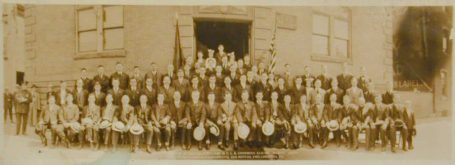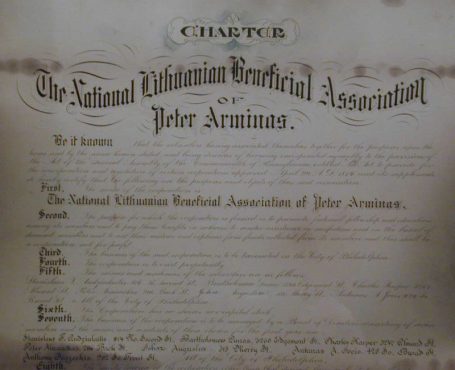Lithuanian Cultural Center of Philadelphia




“Toward the end of the 19th century, the first Lithuanian immigrants settled in South Philadelphia, and later congregated in Northeast Philadelphia. Almost from the beginning, they founded ethnic clubs and organizations.
In the beginning of the 20th century, there were five Lithuanian clubs in the city, among which was the earliest established Gedeminas’ Lithuanian Club. The Gedeminas’ Lithuanian Club, named in honor of an ancient Lithuanian king, was established on January 27, 1895. The founders of the club were some of the first Lithuanian immigrants to the United States and the Philadelphia area. The aim of the Gedeminas’ Lithuanian Club was “to assist in securing citizenship papers for the members and elevate them intellectually and materially.” To help achieve these goals the Gedeminas’ Club also provided lessons in English.
On March 3, 1907, the Lithuanian Music Hall Association was founded. The purposes of the Association were the encouragement, promotion, and support of the Lithuanian ethnic culture, education, science, art, literature, and sports among its members, as well as mutual financial assistance to the members.
The first officers were elected, including Mykolas Valincius, president; Kazys Karpavicius, vice-president; Antanas Gudiatis, secretary; Kazys Kazakauskas, treasurer; and three assistant treasurers: Ignas Liepa, Juozas Litvinas, and Antanas Grabauskas.
As the strength of Lithuanian identity grew, the need arose for a community meeting place for educational and recreational activities. In the second half of 1908, an enthusiastic fund-raising campaign was started to support the construction of a LMHA building.” (Lithuanian Music Hall Association Records Collection, 3043 2, The Historical Society of Pennsylvania.)
“The Lithuanian Music Hall Association, it is said, has commissioned architect Edward F. Judge to prepare plans for a building to be erected on a plot at the corner of Allegheny Ave. and Tilton St.” (American Architect, Volume 93, p. 130, 1908.)
Built in 1908, the Philadelphia Music Hall is older than the republic of Lithuania itself.
"The building, at a cost of $32,600, was erected at the corner of Allegheny and Tilton Streets, and dedicated on December 31, 1908. The building is known as the Lithuanian Music Hall. (Lithuanian Music Hall Association Records Collection, 3043 2, The Historical Society of Pennsylvania.)
In 1907, the Lithuanian Music Hall opened in the Port Richmond area of Philadelphia as a place where Lithuanians could gather. For more than 100 years, it has been a cultural hub for the Lithuanian community in Philadelphia, a place for gatherings such as concerts, cultural evenings, art exhibitions, meetings, commemorations, weddings, and dances.
The hall continues to house a library and cultural center that documents the Lithuanian American experience in Philadelphia and the coal mining towns of Pennsylvania. The collection includes books, records, artifacts and music dating back as far as the 1890s. " (Lithuanian Music Hall Association Records Collection, 3043 2, The Historical Society of Pennsylvania.)
Our facilities are used for folk dance practices, choir rehearsals and various community meetings. A permanent folk-art exhibit is on display.
With the ownership of the Lithuanian Music Hall officially transferred in 2021 to the Lithuanian Cultural Center,
a 501(c)(3) non-profit organization, an exciting future lies ahead.
The Lithuanian Music Hall Association (LMHA) was established on March 3, 1907, from various Lithuanian clubs and organizations in the Philadelphia area. This association was created to support and preserve the ethnic and cultural heritage of Lithuanian Americans, to give financial aid in case of sickness, and to provide mortuary benefits to the organization’s members.
The organization established a library and a reading room, also supporting classes for the study of the Lithuanian and English languages, as well as promoting art. The building at the corner of Allegheny and Tilton Streets in Philadelphia, in which the organization has been located since 1908, is known as the Lithuanian Music Hall, where the LMHA provides a place for concerts, theatrical performances, conventions, various meetings, and social amusements.
In 1943, the American Lithuanian Citizens’ Beneficial Club, which was established in 1902, merged with LMHA. In 1975, the LMHA became a shareholder-owned organization. As of 2004, the LMHA is still in existence. The LMHA is the Philadelphia chapter of the Lithuanian American Community organization.
The collection contains materials of the LMHA as well as the Gedeminas’ Lithuanian Club, the American Lithuanian Citizens’ Beneficial Club, the National Lithuanian Beneficial Club, the Petro Armino Society, the Lithuanian National Independent Club, the First Lithuanian Building and Loan Association, and the Lithuanian Real Estate Company. Some of these organizations were among the first Lithuanian organizations in Philadelphia, which slowly dwindled as members passed away.
The bulk of the collection is a number of income and expense ledgers, mostly of the LMHA. A small amount of correspondence in the collection belongs to the LMHA. Other materials of the LMHA and the above-mentioned organizations and clubs are bylaws, agreements and certificates, a number of minute books, dues and membership data books, records of sick and death benefit claims, and programs and flyers of events. Materials are in Lithuanian and English.




"Philadelphia is among the "most Lithuanian" cities in the USA and has the fourth largest total number of ethnic Lithuanians after Chicago, New York, and Los Angeles (~6000)
It has 3 great Lithuanian churches, pre-war art nouveau Lithuanian halls, a synagogue named after Vilnius, and an abandoned Lithuanian cemetery in its suburbs.
Lithuanian Music Hall in Philadelphia
The prettiest and the last one surviving among Philadelphia's Lithuanian clubs is its especially old (erected 1908) Lithuanian Music Hall, also known as Lietuvių namai ("Lithuanian House") in Lithuanian language and "Big Lit" in English (2715 E. Allegheny Ave). It is a separate red brick building inspired by art nouveau."

© Copyright 2023. All rights reserved.
We need your consent to load the translations
We use a third-party service to translate the website content that may collect data about your activity. Please review the details in the privacy policy and accept the service to view the translations.